
Temperature inversions form a kind of air layering or stratifying effect. It becomes visible when smoke or fog rises and then seems to abruptly hit an invisible ceiling. Credit Judy Biss
Farmers and ranchers must manage traditional business practices to be successful, but they also deal with the many challenges of ever changing weather. Rain, wind, and temperature are important and obvious aspects of weather that producers track on a daily basis, but there are other, not so obvious weather features that affect operational management as well. One of these is a phenomenon called “temperature inversions.”
What is a Temperature Inversion?
Most of the time, if you were to take the air temperature at measured intervals starting from the ground, moving straight up in to the air, the temperature would be warmer at ground level than it is at higher levels over your head. A temperature inversion is simply the reverse of this gradient – the temperature of air at ground level is cooler than the air above it. These inversions occur naturally and most often in the late evening to early morning hours when there is little to no wind. Temperature inversions form a kind of air layering or stratifying effect. If you have ever seen smoke rise and then seemingly, and abruptly, hit an invisible ceiling, you have probably witnessed a temperature inversion.
Why are Temperature inversions important?
Temperature inversions are important because the air layering effect they cause changes the anticipated dissipation of pesticide spray solutions used by agricultural producers. Inversions also affect the movement of smoke from prescribed fires used by land managers. Under a temperature inversion, spray solutions and smoke have the potential to move great distances offsite instead of dissipating and diluting under normal atmospheric conditions. To make a long story short, agricultural producers and land managers do not want their pesticide spray solutions or smoke to move offsite in such a way that could negatively affect non-targets areas. Minimizing pesticide drift is a critical and routine part of pesticide application procedures. There are a number of techniques pesticide applicators use to reduce pesticide drift. One of these techniques is being aware of atmospheric temperature inversions. This is especially important when using organo-auxin herbicides that have characteristics making them more volatile, and thus more affected by air currents. Additionally, in light of the new herbicide application rules for dicamba resistant cotton and soybean varieties, managing pesticide drift is a critical part of stewardship of these new herbicides.
Detecting and Managing Temperature Inversions
Properly managing pesticide drift and smoke from prescribed fire includes using a number of best management practices by trained applicators and managers. Being aware of temperature inversions is only one of the variables they incorporate into their management decisions every day. Some herbicide labels have sections dedicated to explaining the importance of not spraying in areas where temperature inversions exist, and list ways to detect the presence of an inversion. See for example, the herbicide Engenia® by BASF. This is one of the herbicides approved for use on the new dicamba resistant cotton and soybean varieties. Before herbicides approved for use on these new plant varieties can be used, the pesticide applicator must attend a specialized training on proper stewardship of these products.
The Engenia® Herbicide Resource Center provides a number of Technical Information Bulletins, one of which details Recognizing Temperature Inversions. Below is an excerpt from that bulletin.
How to Identify if an Inversion Exists:
- Measure air temperature at 6–12 inches above the soil and at 8–10 feet above the soil. An inversion exists if measured air temperature at 8–10 feet above the soil is higher than the measured air temperature at 6–12 inches above the soil. Be sure the instrument is shaded and not influenced by solar heating.
- Morning dew
- Morning fog (indicates that an inversion existed prior to fog formation)
- Smoke or dust hanging in the air or moving laterally
- Overnight cloud cover is 25% or less
- Inversions can begin forming three to four hours before sunset and can persist until one to two hours after sunrise
This 3 minute video from the University of Minnesota Extension, provides great information on temperature inversions and how to detect them.
For additional resources on the topic of Temperature Inversions and Pesticide Drift Management, please see the following publications:
-
Managing Pesticide Drift
-
Southern IPM Center – Temperature inversion and herbicide applications
-
Air Temperature Inversions Causes, Characteristics and Potential Effects on Pesticide Spray Drift (AE1705 (Revised))
-
Understanding Air Temperature Inversions Relating to Pesticide Drift (AE1876)
-
Using Dicamba on Dicamba-Tolerant Crops
-
Smoke Dispersion
-
FDACS Florida Forest Service Fire Weather
- Maintaining Dissolved Oxygen Levels in Your Pond to Reduce Fish Kills - September 21, 2018
- The Bumble Bee – One of Florida’s Vital Pollinators - September 14, 2018
- 2017-2018 Bee Informed Partnership’s National Bee Colony Loss Report - July 13, 2018
